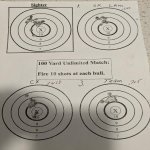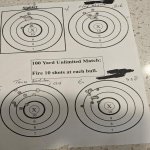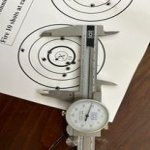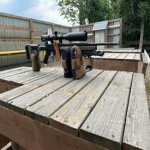On a related note, the "extra" left-right spread that may not be explained by wind alone can also be seen in "extra" vertical (up-down) spread that's not accounted for by MV differences. This is largely unrelated to wind variation, at least with relatively light wind conditions.
MV and POI mismatch can be a frequent characteristic of .22LR ammo.
With standard velocity .22LR, a rough figure of .25" vertical spread for each 10 fps difference in MV is often cited. To be a little more precise, according to Gundata.org's ballistics calculator, for every 10 fps difference in MV there is a vertical difference of 0.265". In other words, two rounds whose MV is 10 fps should have POI about .265" in vertical (This figure was calculated using 1070 fps and 1080 fps.)
The small group on target #3 (bottom right) has a vertical spread of about 0.480". The ten rounds that made that group had a muzzle velocity spread of 29.4 fps. According to ballistics, an approximately 30 fps spread should result in about .75" of vertical.
The small group on target #6 had a vertical dimension also of about .480" and its ten rounds had a muzzle velocity spread of 13.5 fps. That seems more in line with vertical spread expected from that MV spread.
Another result that's intriguing is that the POI's that were the highest or the lowest in a group were not necessarily those with the fastest or slowest MV. For example in target #1, top right bull, the POI that was lowest had the fastest MV of all ten rounds. No scope adjustments were made when shooting that group. Also on target #1, on both bottom bulls, neither of the highest POI's were from the fastest rounds of each group.
When it comes to MV and POI mismatch, compared to other lots of Midas that I shot last year, at this point in the testing these two lots seem a little better. But that the MV and POI mismatch occurs is a problem about which shooters should be aware. The assumption that an unexpectedly high or low POI is the result of an unusually fast or slow round is not one that will necessarily be what's actually happening.
_______________________________
The point here is that .22LR match rounds don't always go where the wind (or its absence) or the MV would predict. Sometimes rounds have unexpected and unpredictable trajectories, the explanation for which lies elsewhere.
MV and POI mismatch can be a frequent characteristic of .22LR ammo.
With standard velocity .22LR, a rough figure of .25" vertical spread for each 10 fps difference in MV is often cited. To be a little more precise, according to Gundata.org's ballistics calculator, for every 10 fps difference in MV there is a vertical difference of 0.265". In other words, two rounds whose MV is 10 fps should have POI about .265" in vertical (This figure was calculated using 1070 fps and 1080 fps.)
The small group on target #3 (bottom right) has a vertical spread of about 0.480". The ten rounds that made that group had a muzzle velocity spread of 29.4 fps. According to ballistics, an approximately 30 fps spread should result in about .75" of vertical.
The small group on target #6 had a vertical dimension also of about .480" and its ten rounds had a muzzle velocity spread of 13.5 fps. That seems more in line with vertical spread expected from that MV spread.
Another result that's intriguing is that the POI's that were the highest or the lowest in a group were not necessarily those with the fastest or slowest MV. For example in target #1, top right bull, the POI that was lowest had the fastest MV of all ten rounds. No scope adjustments were made when shooting that group. Also on target #1, on both bottom bulls, neither of the highest POI's were from the fastest rounds of each group.
When it comes to MV and POI mismatch, compared to other lots of Midas that I shot last year, at this point in the testing these two lots seem a little better. But that the MV and POI mismatch occurs is a problem about which shooters should be aware. The assumption that an unexpectedly high or low POI is the result of an unusually fast or slow round is not one that will necessarily be what's actually happening.
_______________________________
The point here is that .22LR match rounds don't always go where the wind (or its absence) or the MV would predict. Sometimes rounds have unexpected and unpredictable trajectories, the explanation for which lies elsewhere.
Last edited:






























































































